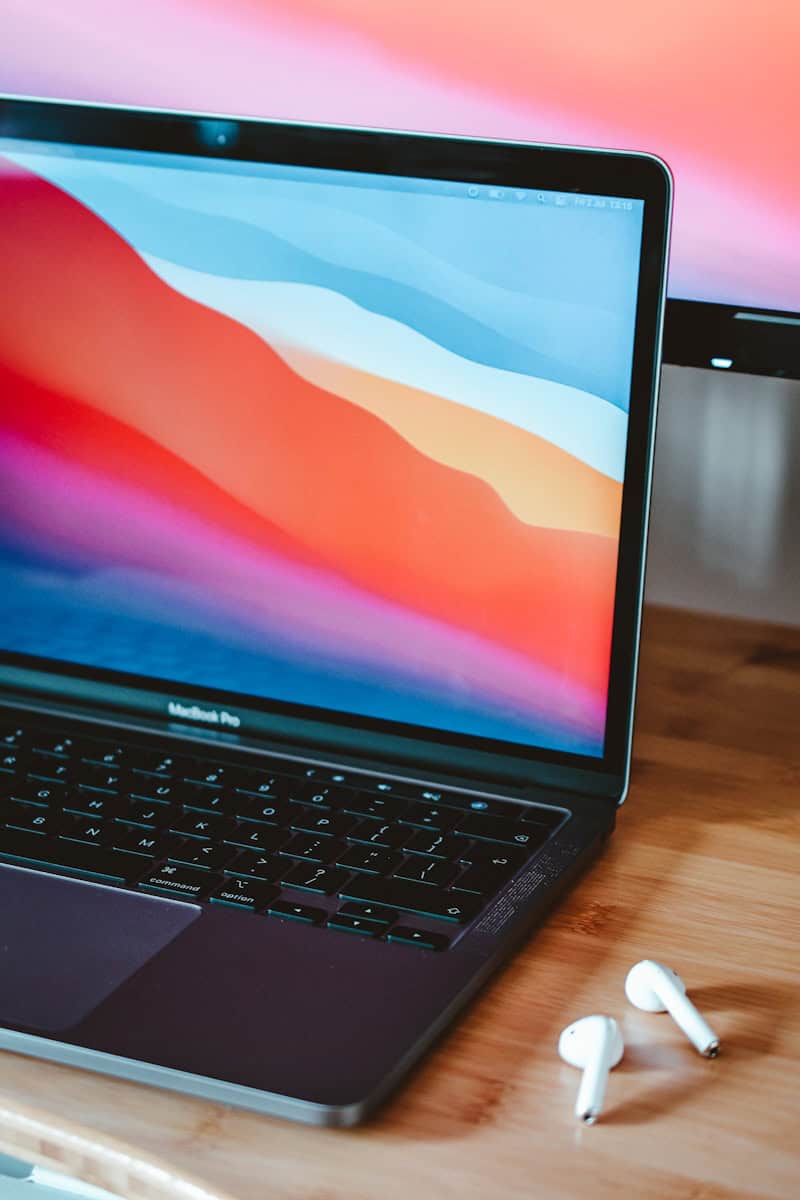Connecting your AirPods to a laptop opens up a new level of wireless convenience for work and entertainment. You can easily pair AirPods with both Windows and Mac laptops through Bluetooth settings by placing them in pairing mode and selecting them from your computer’s device list. While AirPods are designed primarily for Apple devices, they function perfectly well with Windows computers with only a few feature limitations.
The process is straightforward and takes just a minute to complete. For Windows users, you’ll need to access your Bluetooth settings through the Settings app or taskbar, then put your AirPods in pairing mode by holding the button on the back of the case. Mac users enjoy an even simpler connection process with automatic device detection when signed into the same Apple ID.
Connecting AirPods to a Laptop: A Step-by-Step Guide for Windows and macOS Users
AirPods aren’t just for iPhones. Whether you’re using a Windows laptop or a MacBook, pairing AirPods is quick and seamless once you know where to look. Below is a comprehensive walkthrough for both operating systems, complete with troubleshooting tips and audio settings adjustments to help you get the most out of your AirPods.
How to Connect AirPods to a Windows Laptop
Even though AirPods are part of the Apple ecosystem, they function like any other Bluetooth headphones on Windows. Here’s how to get them working:
1. Turn on Bluetooth on Your Laptop
- Click the Start button and select Settings.
- Navigate to Devices > Bluetooth & other devices.
- Toggle Bluetooth to On.
2. Put Your AirPods in Pairing Mode
- Place your AirPods in the charging case and open the lid.
- Press and hold the button on the back of the case until the LED starts flashing white. This means they’re ready to pair.
3. Connect AirPods from Your Laptop
- On your laptop, click Add Bluetooth or other device.
- Choose Bluetooth and wait for your AirPods to appear in the list.
- Click on your AirPods (they’ll usually show up as “AirPods” or “[Your Name]’s AirPods”) and hit Connect.
4. Confirm and Test Audio
Once connected, you should see a confirmation. Play a video or song to test audio playback through your AirPods.
How to Connect AirPods to a MacBook
On a Mac, the process is a bit more streamlined, especially if you’re using the same Apple ID across devices.
Option 1: Automatic Connection via iCloud
If your AirPods are already paired with your iPhone or iPad and you use the same Apple ID on your Mac:
- Open the AirPods case.
- Click the Volume or Bluetooth icon on your Mac’s menu bar.
- Select your AirPods from the list.
They should connect instantly without needing to manually pair.
Option 2: Manual Pairing
If the AirPods haven’t been used with your Apple ID:
- Open System Settings > Bluetooth.
- Open the AirPods case and hold the pairing button until the LED flashes white.
- You’ll see the AirPods in the Bluetooth list. Click Connect.
Audio Output Settings (Optional)
To make sure your Mac is using the AirPods as the primary output:
- Go to System Settings > Sound.
- Under “Output,” select your AirPods.
Common Issues and Fixes
AirPods Not Showing Up in Bluetooth List?
- Make sure they’re in pairing mode (LED must be flashing white).
- Restart Bluetooth on your device.
- Reboot your laptop if the issue persists.
Sound Cutting In and Out?
- On Windows, go to Control Panel > Sound > Playback, select AirPods, and make sure the “Hands-Free AG Audio” profile is disabled for better sound quality.
- On macOS, ensure that your AirPods are set to “Output” only and not being used as a microphone unless necessary.
Microphone Not Working?
- In macOS, check System Settings > Sound > Input and select your AirPods.
- On Windows, head to Sound settings > Input device and choose AirPods.
Extra Tips for a Better AirPods-Laptop Experience
- Update Your Drivers (Windows): Make sure your Bluetooth drivers are up to date for smoother pairing and stability.
- Battery Status on Mac: Tap the Bluetooth icon in the menu bar to see the battery level of each AirPod and the case.
- Rename Your AirPods: On a Mac or iPhone, renaming your AirPods can make them easier to spot when connecting to a Windows laptop later.
AirPods are surprisingly versatile, and pairing them with a laptop—whether Mac or Windows—is easier than many expect. Once connected, you can use them for video calls, music, or even casual gaming. As wireless headphones become increasingly essential for hybrid work and digital life, knowing how to get your AirPods working across platforms is a small skill that goes a long way.
Key Takeaways
- AirPods connect to any laptop with Bluetooth capabilities through the pairing mode and device selection process.
- Windows users can access full audio functionality but may miss some Apple-specific features available on Macs.
- Most connection issues can be resolved by resetting your AirPods or updating your computer’s Bluetooth drivers.
Understanding AirPods Compatibility
AirPods work with Windows laptops through Bluetooth technology, offering versatility beyond Apple’s ecosystem. Various models including AirPods Pro and AirPods Max can connect to Windows devices with different levels of functionality.
Compatibility with Different Windows Versions
Windows 10 and Windows 11 both support AirPods connectivity through their built-in Bluetooth systems. The connection process remains largely similar across these versions, with settings accessed through the Devices menu.
Both standard AirPods and advanced models like AirPods Pro and AirPods Max work with Windows laptops. However, some special features may be limited compared to when used with Apple devices.
The latest AirPods 4 maintains compatibility with Windows while offering enhanced features. Users should ensure their Windows laptop has Bluetooth capability, which is standard in modern devices.
Connection quality depends on:
- Bluetooth version (newer is better)
- Physical distance between devices
- Environmental interference
For optimal performance, keeping Windows and device drivers updated is recommended. This ensures the most current Bluetooth protocols are supported.
Preparing Your AirPods for Connection
Before connecting your AirPods to your laptop, you need to make sure they’re properly prepared. This involves checking their battery level and activating the pairing mode so your laptop can discover them.
Checking AirPods Charge Level
AirPods need sufficient battery power to establish and maintain a connection with your laptop. To check the battery level, place your AirPods in their charging case and open the lid near your iPhone. A battery status pop-up will appear showing charge levels for both the AirPods and the case.
For non-iPhone users, look at the LED indicator on the charging case. A green light means the AirPods are fully charged, while an amber light indicates they need charging.
If the battery is low, charge your AirPods by placing them in their case and connecting it to a power source using a Lightning cable. Even a 5-minute quick charge can provide enough power for a short listening session.
Placing AirPods in Pairing Mode
To connect AirPods to a laptop, they must be in pairing mode. Start by placing the AirPods in their charging case and opening the lid.
Next, locate the setup button on the back of the charging case. Press and hold this button for about 3-5 seconds until the LED indicator on the front or inside of the case begins flashing white. This white flashing light confirms the AirPods are now in pairing mode and ready to connect.
For previously paired AirPods, they might automatically enter pairing mode when placed near your laptop with Bluetooth enabled. Keep the AirPods case open during the entire connection process to maintain pairing mode.
Connecting AirPods to a Windows Laptop
Apple AirPods can work seamlessly with Windows laptops despite being designed primarily for Apple devices. The connection process requires accessing Bluetooth settings, putting AirPods in pairing mode, and confirming the connection is successful.
Accessing Bluetooth Settings on Windows
To connect AirPods to a Windows laptop, you first need to access the Bluetooth settings. On Windows 10 or Windows 11, this can be done in several ways:
- Click the Start menu → Settings → Devices → Bluetooth & other devices
- Use the Action Center – Click the notification icon in the taskbar and select “Bluetooth”
- Search for “Bluetooth” in the Windows search bar
On Windows 11, you can also right-click the Bluetooth icon in the taskbar if it’s visible. The interface looks slightly different between Windows 10 and 11, but the pairing process remains similar.
Make sure Bluetooth is turned ON before proceeding. If your laptop doesn’t have Bluetooth functionality built-in, you’ll need to purchase a Bluetooth adapter to continue.
Pairing AirPods to Your Laptop
Once you’ve accessed the Bluetooth settings, follow these steps to pair your AirPods:
- Open the AirPods case and keep the lid open
- Press and hold the setup button on the back of the case until the status light flashes white
- On your Windows laptop, click “Add Bluetooth or other device”
- Select “Bluetooth” from the options presented
- Wait for “AirPods” to appear in the list of available devices
- Click on “AirPods” to initiate the pairing process
The process works for all AirPods models, including AirPods Pro and AirPods Max. For AirPods Max, press and hold the noise control button until the status light flashes white.
If your AirPods don’t appear in the list, close the lid, wait about 15 seconds, and try again.
Confirming a Successful Connection
After selecting your AirPods from the device list, Windows will attempt to connect to them. You’ll know the connection is successful when:
- You see a “Your device is ready to go!” message
- Your AirPods appear under the “Audio” section in Bluetooth devices
- You hear the familiar AirPods connection sound
To test the connection, play audio from any application on your laptop. The sound should come through your AirPods. If you experience any issues, try adjusting the volume or selecting your AirPods as the default output device.
Your AirPods should automatically reconnect to your Windows laptop when you take them out of the case. If they don’t, you can manually connect them through the Bluetooth settings menu.
Troubleshooting Connection Issues
When AirPods refuse to connect to laptops, several common issues may arise that prevent proper functionality. These problems typically stem from Bluetooth connectivity, audio configuration settings, or outdated drivers.
Resolving Audio Playback Problems
AirPods may connect to a laptop but fail to play audio properly. This often happens because Windows recognizes AirPods as two separate devices: “AirPods Stereo” and “AirPods Hands-Free AG Audio.” If no sound comes through after connecting, users should:
- Open Sound Settings in Windows
- Right-click on “AirPods Stereo” and select “Connect”
- Set AirPods as the default audio output device
Some users have found success by accessing playback devices directly rather than connecting through Bluetooth settings. This alternative method often resolves issues when standard connection attempts fail.
If audio quality seems poor, check that “AirPods Stereo” is selected rather than the Hands-Free option, which prioritizes microphone functionality over sound quality.
Reconnecting After Initial Pairing
AirPods sometimes disconnect or refuse to reconnect after successful initial pairing. This frustrating issue can often be resolved through a few simple steps:
First, try a basic reset by placing AirPods in their case, closing the lid for 15 seconds, then reopening. For AirPods 4, double-tap the front of the case until the status light flashes white.
If that doesn’t work, completely remove the AirPods from the laptop’s Bluetooth devices:
- Go to Settings > Devices > Bluetooth
- Select AirPods and click “Remove device”
- Put AirPods in pairing mode again (hold button on case until light flashes)
- Add them as a new device
This re-pairing process fixes most connection problems by establishing a fresh Bluetooth link.
Updating Bluetooth Drivers
Outdated or corrupted Bluetooth drivers are common culprits behind AirPods connection failures on Windows laptops. Modern AirPods require current Bluetooth standards to function properly.
To update Bluetooth drivers:
- Right-click on the Start menu and select “Device Manager”
- Expand the “Bluetooth” category
- Right-click on the Bluetooth adapter and select “Update driver”
- Choose “Search automatically for updated driver software”
If Windows cannot find newer drivers, visit the laptop manufacturer’s website to download the latest Bluetooth drivers directly. Bluetooth glitches often resolve after proper driver updates.
Some users benefit from completely uninstalling and reinstalling Bluetooth drivers. After uninstalling through Device Manager, restart the computer, and Windows will reinstall fresh drivers automatically.
Maximizing AirPods Features on Windows
While AirPods are designed primarily for Apple devices, Windows users can still access several features to enhance their audio experience. Getting the most from your AirPods on a Windows laptop requires some adjustments to optimize both sound and microphone performance.
Utilizing Spatial Audio
Although native Spatial Audio support isn’t available on Windows, users can approximate this immersive experience through third-party solutions. Apps like Dolby Access or Windows Sonic can enhance audio dimensionality when using AirPods.
To enable Windows Sonic:
- Right-click the volume icon in the taskbar
- Select “Spatial sound”
- Choose “Windows Sonic for Headphones”
For AirPods Pro and AirPods Max users, the built-in head tracking capabilities still work to some extent even on Windows. The base audio positioning remains functional, though without the full integration found on Apple devices.
Windows 11 introduced improved Bluetooth audio codecs that better support wireless headphones like AirPods. Users should ensure their Bluetooth drivers are updated to benefit from these improvements.
Adjusting AirPods Microphone Settings
AirPods’ microphones can be configured for optimal performance on Windows through the Sound Control Panel. Users may need to troubleshoot common issues like low volume or poor quality.
To optimize microphone settings:
- Open Sound settings via Control Panel
- Select the “Recording” tab
- Right-click your AirPods and choose “Properties”
- Adjust levels and enhancements as needed
For video conferencing, users should select AirPods as both the input and output device in their meeting software settings. This ensures proper audio synchronization during calls.
The AirPods’ automatic ear detection works partially on Windows. While the pause/play functionality may be inconsistent, users can still benefit from the dual microphone system that filters background noise during calls.







